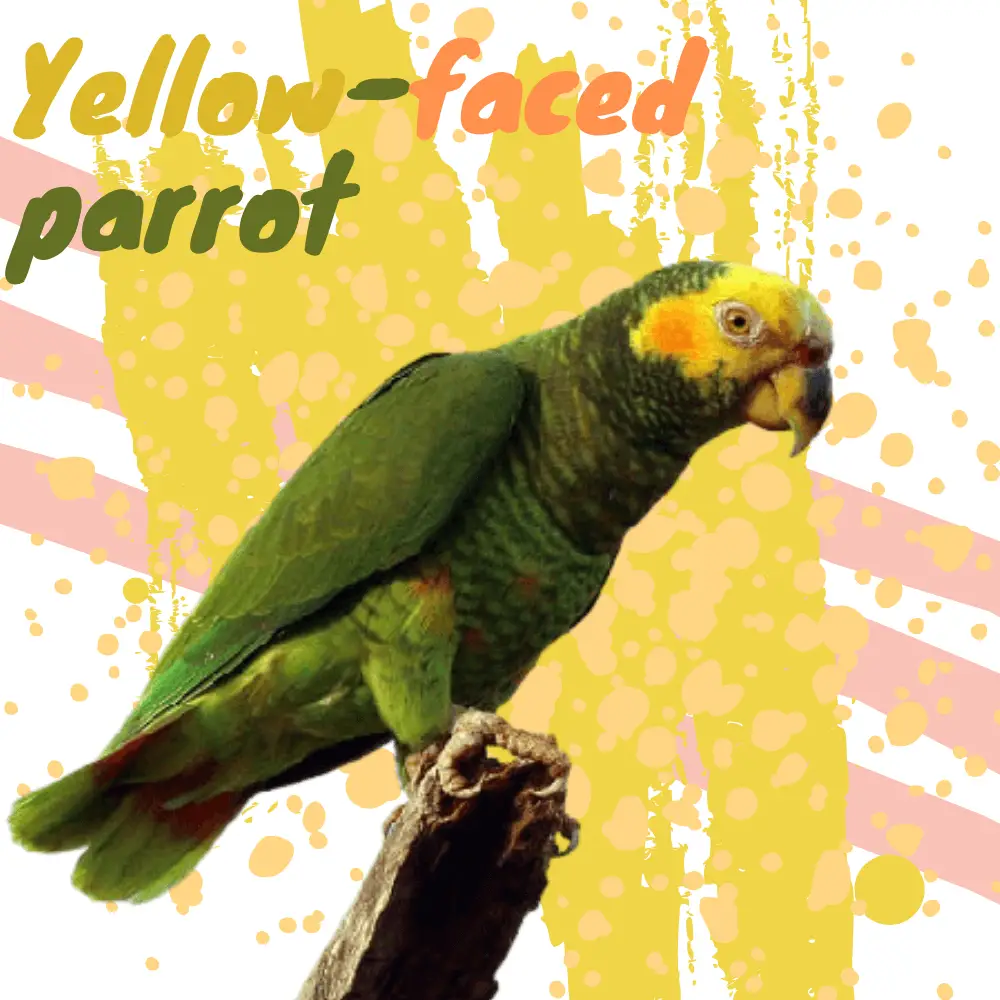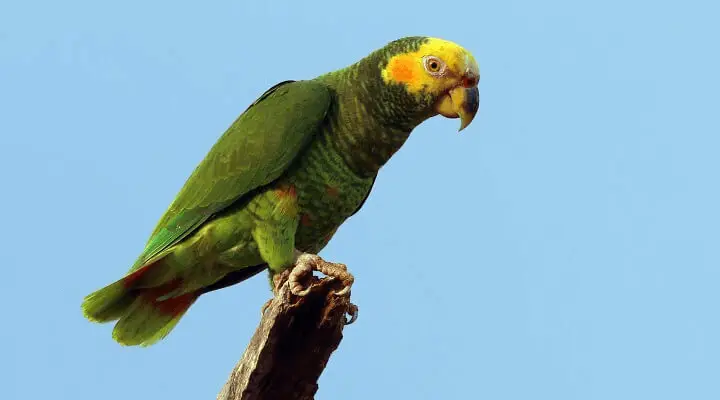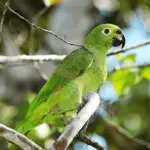
The Yellow-faced Parrot (Poicephalus flavifrons) has bright yellow forecrown lores, cheeks, and ear-coverts, often with an orange wash; small area with yellow feathering around the cheek, often with a brown-grey color tint.
The feathers of the nape, mantle Yes collars dark green with paler areas and brighter green margins; Grupa Yes Uppertail -coverts lighter green and brighter than the rest of the upperparts.
Upper, the coverts Green dark green with light green margins, sometimes yellow at the edge of the wing and at the base of the more prominent primary coverts.
The primary and the secondary of marrón color con extrechos márgenes más claros in los external vanes . Chin Yes thighs sometimes dotted with yellow; underparts a uniform glossy green.
Blackish-brown tail; 28cm. length and weight between 140 Yes 205 grams.
Upper jaw Blackish gray, lower whitish; orange-red irises; legs Gray-brown color.
The mask of the females they don’t have the Orange wash.
Immature like adults, but the mask is olive green, not yellow.
The parrot is a bird of the Psittacidae family, its scientific name is Alipiopsitta xanthops, being known in English as Yellow-faced Parrot. Popularly known as the yellow-bellied parrot, the Papagaio-Galego, the cured parrot, and the guava parrot.
Order: Psittaciformes
Family: Psittacidae
Genus: Poicephalus
Scientific name: Poicephalus flavifrons
Protonimo : pionus flavifrons
Yellow-faced Parrot Habitat
The Yellow-faced Parrot, generally, lives in the forests of Juniperus Yes Podocarpus, at altitudes between 1,800 Yes 2,900 m, mainly in trees of the genus Hagenia, which are above the 2,900 m.
Also found in forest glades, with Ficus trees interspersed with cultivated plateau areas and in gallery forests of Savannah Acacia. Also in the riparian forests of Acacias Yes Ficus, from Los 800 m.
Occasional visits to urban areas, for example, gardens and parks in Addis Ababa.
Usually seen in pairs, small groups of family members, or in flocks of up to 20 birds; often in mixed herds with the Abyssinian Lovebird (Agapornis taranta).
The Yellow-faced Parrot probably uses the same trees produced every night.
Yellow-faced parrot reproduction
They are monogamous birds, and the Yellow-faced parrot nests in crevices, natural holes in the trees, and also uses abandoned termite mounds. The female of the parrot lays about 2 to 4 eggs, incubated for about 28 days.
After birth, the baby parrot will be treated by both parents, until it can live alone. It is a bird not used to captivity, so its reproduction is a little complicated.
Breeding habits are largely unknown but are suspected to usually nest in tree cavities.
The incubation time is 28 days. Birds fly from the nest after some 80 days after incubation. Even in this case, by generating this, the parents feed until its full independence from l.
Yellow-faced Parrot, Alipiopsitta xanthops, Perfect camouflage, Papagaio-galego,
SOURCE:Fauna and Flora
Distribution of the parrot
It is an endemic species of cerrado, but not from Brazil. It has a wide distribution occurring from the south of Piauí / Maranhão, passing through the midwest states such as Tocantins, Goiás, Mato Grosso, Mato Grosso do Sul to the North of São Paulo and Bolivia. Its habitat is in the cerrado, cerradão, caatinga, gallery forests, and buritizais.
Endemic to the West Highlands of Ethiopia, although its exact range is unclear.
Common in wooded areas; more common in the upper, northern parts of its range.
Probably sedentary Although there have been some periodic movements in Addis Ababa.
Physical characteristics of the parrot

The parrot is at risk of extinction due to the increasing scarcity of savanna areas in Brazil, which have been systematically cleared for monocultures.
The loss of habitat due to the expansion of agriculture and cultivated pastures, mainly in the savannas of the surrounding highlands and edges of the Pantanal, represent serious threats to this parrot.
The species is not one of the most commercially targeted for smuggling, because it is among those that do not speak much, however, their plumage is very beautiful.
It is a very shy species and does not easily learn to speak like the true parrot. It is considered very aloof when it detects the presence of any individual, flies, and lands in places of difficult access.
These parrots measure between 25 to 27 centimeters in length and weigh around 300 grams, have a light green plumage, with a yellow belly and head, and the beak is curved pink with a dark horn-colored spot
Yellow Faced Parrot Diet
They consume fruits, seeds, and flowers present in their habitat. The most consumed vegetable species of the bird are Pequi, Leucena, Pau-terra, and Sucupira. They also consume clay and tree bark.
what do parrots eat and drink
Your diet is created that consists of grains, seeds, and fruits. They were also seen eating the ripe fruits of Dovyalis abyssinica . Considered a crop pest in some areas, although of little importance.
Yellow Faced Parrot Preservation
• IUCN Red List: Least Concern
• Population trend: Stable
The size of the global population has not been quantified, but the species is reported infrequent to common. It is more common in the northern parts of its range.
The population is suspected to be stable in the absence of evidence of reduction or serious threats.
Yellow-faced parrot in captivity
It is a rare kind in captivity outside Ethiopia . No data hay on reproduction.
The female sons practically impossible to conseguir.
How to download or listen to Galician parrot songs
You can download the song of the Yellow-faced parrot on our website. To do this, just right-click on the name of the song, then click on (Save Link As..and choose the place where it will be saved). You can also listen, just click on the play button.
Yellow-faced parrot singing




















